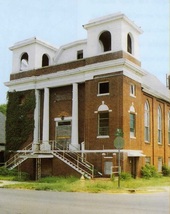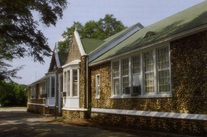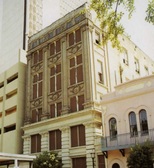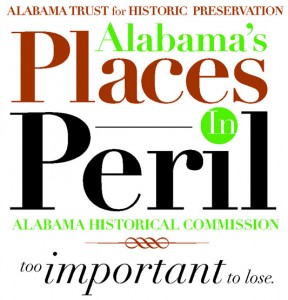 Click image to enlarge.
Click image to enlarge.
"Chapman's Quarters" and Griffin Hotel, Athens, Limestone County, c.1920 (Places in Peril 1999)10/25/1999  Click image to enlarge. Click image to enlarge. Across the tracks from Athens' adaptively renovated 1907 depot, a picturesque business row stands as a reminder of the intimate physical link that once existed between railroad transportation and commerce throughout small-town America. While countless older commercial districts in Alabama struggle to remain alive, downtown Athens thrives. Stores are full in the short block between the old depot and handsome courthouse square, and a number of vintage commercial structures have been attractively refurbished or, better still, continuously maintained.
1 Comment
Because the log house epitomizes the frontier heritage of which so many Alabamians are proud, it is ironic that so few of these historic structures survive today. Those that do rarely retain their historic character. A recent county-wide survey in Lawrence County (sponsored jointly by the Lawrence County Historical Commission and the Alabama Historical Commission) has turned up a remarkable concentration of more than thirty antebellum log houses in the southern part of Lawrence County, most of which are abandoned or neglected.
Mount Zion A.M.E. Zion Church, Montgomery, Montgomery County, 1899 (Places in Peril 1999)10/25/1999  Click image to enlarge. Click image to enlarge. One of only a handful of existing churches in downtown Montgomery that played a significant role in the Civil Rights Movement, the Mount Zion A.M.E. Zion Church, located at the corner of Holt and Stone Streets, is undergoing the slow process of demolition by neglect, as is much of the neighborhood around it. One of the oldest African American communities in Montgomery, the area was once a bustling business and residential district whose residents were at the forefront of the Civil Rights Movement. In 1955, under the leadership of Rev. L. Roy Bennett, the Mount Zion Church became the birthplace of the Montgomery Improvement Association, a group that played a leading role in the organization of the Montgomery Bus Boycott.  Click image to enlarge. Click image to enlarge. The halls of Pinson Elementary School have resonated with the patter of little feet for seventy-eight years. Known as the "rock school" to many locals because of its cobblestone veneer, the building--most recently used as a day-care center--is typical of many of Alabama's historic schools of the 1920s. And like many others of the same era, the Pinson School is slated for demolition, in this case to make way for a larger school on the same site. Members of the local Turkey Creek Historical Society are trying to save the school for use as a community center or other adaptive re use. Unfortunately, they have had little success in eliciting support from the Jefferson County school board.  Click image to enlarge. Click image to enlarge. Masonic Hall, the first building in Mobile to utilize steel-frame construction, was designed and built by Stone Brothers, a New Orleans architectural firm, for a mere fifty thousand dollars. The design details and ornamentation of the structure are reminiscent of the Chicago School of Architecture (1880-1910)--a group of Chicago architects who were known for major developments in skyscraper design and for experiments in modem architectural style for business and industrial settings. Among the best known was Louis Sullivan. Like many buildings of the Chicago School, the Masonic Hall employs terracotta, cast stone, and cast-iron ornamentation as decoration. A masonic symbol can even be found in the terracotta laurel wreath s on the building's main facade. |
Alabama's Endangered Historic LandmarksEach year since 1994, Alabama Heritage has highlighted threatened historic sites throughout Alabama. The “Places in Peril” list has identified more than 215 imperiled historic resources throughout the state, and is compiled by the Alabama Historical Commission and the Alabama Trust for Historic Preservation. The locations highlight the results of deferred maintenance, perceived obsolescence, development pressures, and lack of funding—forces that now more than ever threaten our cultural legacy. But awareness is a powerful force, too, and can cultivate a renewed determination to be responsible stewards of our heritage. For more information, visit the AHC or the ATHP websites. Alabama Heritage is proud to bring to you a selection of the places designated as perilous. Please keep your comments to information relevant to the featured place in peril. Alabama Heritage reserves the right to delete any comment that we deem inappropriate. Archives
May 2024
|

 RSS Feed
RSS Feed